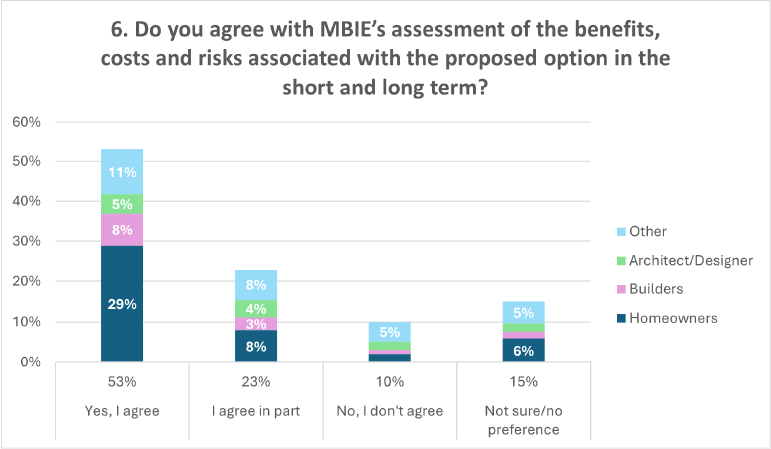Question 6
On this page I tēnei whārangi
What was asked
Question 6: Do you agree with MBIE’s assessment of the benefits, costs and risks associated with the proposed option in the short and long term?
What was proposed
The discussion document included a list of risks associated with the proposed approach:
- Without the oversight of Building Consent Authorities, there is an increased risk of non-compliant buildings. The notification requirement, and other criteria, are proposed to help mitigate this risk. It is unclear whether these mitigations will be enough to resolve potential difficulties with finance, insurance, and re-sale.
- The proposal makes owners responsible for ensuring qualified professionals complete the work. However, as no entity would be actively monitoring this requirement, there is a risk of non-compliance.
- Creating a new schedule to the Building Act also adds complexity to the building regulatory system.
Summary of feedback
Overall, 1,450 submitters answered this question. Figure 6 below shows a breakdown of their responses.
Figure 6: Graph detailing the response to question

Text description of graph - Figure 6: Graph detailing the response to question 6
Submitters were also given the opportunity to explain their views on this question. 392 submitters provided a further explanation of their view.
Homeowners
Overall, homeowners agreed with the assessment contained in the discussion document. Homeowners emphasized the social and economic benefits of intergenerational living. Furthermore, this demographic commented on the need for more affordable housing and noted that the proposal could help increase the housing stock and positively impact the rental market.
Some homeowners disagreed because they believed the costs and risks identified were an overestimation, whilst others viewed these as an underestimation. Additionally, homeowners who disagreed highlighted the long-term risks regarding compliance, insurability, and liability associated with the proposal. In these cases, respondents argued that the risks associated with the proposal did not outweigh the benefits.
Iwi, hapū and Māori
Most iwi, hapū and Māori submitters agreed with the assessment within the discussion document but did not provide further comments. Of those who disagreed, the key reason provided was that even under the current process, non-compliant buildings were common, and the mitigations provided in the proposal were insufficient to address the increased risk.
Councils (including Building Consent Authorities) and Industry
Feedback received from councils and industry stakeholders was largely consistent. Submitters expressed support for the potential benefits, however, the feedback stated that the long-term costs and risks of the proposal were understated and potentially outweighed the benefits.
The most common reason provided for disagreement with the assessment was the risk of poor-quality housing arising due to a lack of compliance, monitoring, and enforcement. Without a third party checking off building work, submitters voiced concerns as to whether the current Licensed Builder Practitioners scheme is sufficient.
Industry submitters provided anecdotal experiences of non-compliance within the existing regime as an argument against the proposal to reduce oversight. Furthermore, several councils cited inspection failure rates under the existing regulations as a reason to be wary of reducing council involvement.
Submitters further stated that the assessment inaccurately reflected consenting costs proportionate to total building costs, and that the stated cost savings were minimal and did not outweigh other costs such as building materials, or the potential costs of remedying non-compliant building work in the long term.
Council and industry submitters also commented on the responsibility the proposal places on homeowners to ensure qualified professionals complete the building work and the associated risks. These comments stressed the risk to homeowners of not having code compliance certificates. Submitters questioned the impacts on insurability and finance, noting that insurance companies currently rely on code compliance certificates and raised the matter of how homeowners would be able to prove retrospectively that the building was built to code. Submitters expressed concern that homeowners may not appreciate the risks involved in undertaking building under the proposed option.
The management of infrastructure, water servicing, and stormwater were also points of concern among this submitter type. Submitters questioned whether local governments could cope with providing the additional services required for widespread unplanned building density. To mitigate this risk, submitters stressed the importance of having an official record of the completed work.

